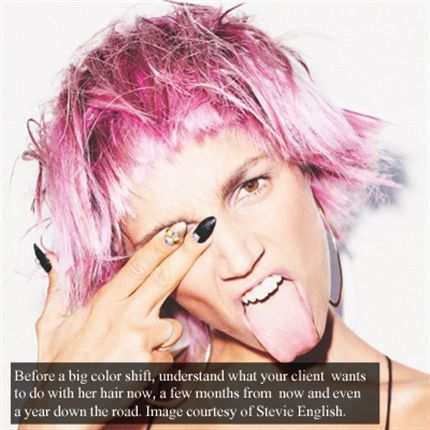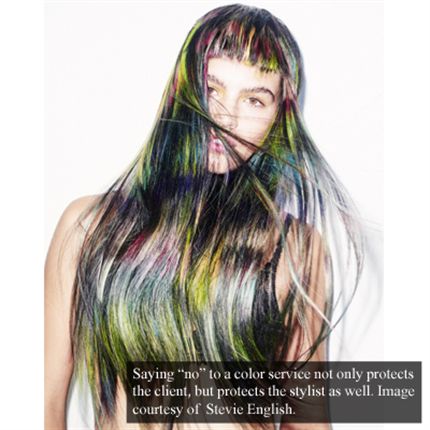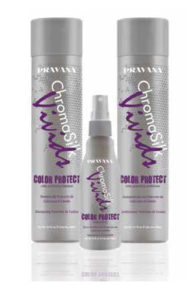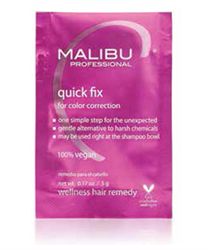The Reality of Color Jumping
Everything You Need to Know About Extreme Color Conversions
By Katie Harrington
A year ago she went through a messy breakup and mended her broken heart with pink hair. Then she saw Kylie Jenner and demanded her electric blue hue. Now she’s eyeing a bright red. You love her chameleon tendencies, and you want to exceed all her color expectations, but the reality is, frequently switching from one extreme color to another isn’t always possible, and there are right (and wrong) ways to do it. Here’s how to stay in control with all of your color shifting clients.
The Consultation
First things first. “The key to everything is always in the consultation,” says Ian Michael Black, Aveda Artistic Director, Hair Color. Before any big color shift, you must understand where the hair has been and where you want to take it—now, a few months from now and even a year down the road.
“It’s important to understand what the client is hoping to achieve,” affirms Malissa Peterson, Malibu C Wellness Educator. “You need to set realistic expectations by discussing whether the color they are choosing is reasonable and if it can be done in one appointment, or if it requires multiple appointments.”
Here are six consultation topics you should always cover:

1. Frequency of Salon Visits. Is she dead set on a bright fashion color? If so, she’ll need to return to the salon about every three weeks to maintain the
vibrancy of the shade. If she’s OK with fading, she can wait up to 12 weeks.
2. Consider Her Lifestyle. If it seems like she’s making an impulsive decision, ask her to consider how a color change might affect her life. If she has a traditional job, for example, lime green hair might not be the best idea.
3. Understand Why. Does your client change her color based on mood? Every time she comes into the salon? “To me, it’s about understanding why they want that big change,” says Ian. “Sometimes you have to ask, ‘Is this something you really want right now?’”
4. Talk Time. Use the consultation to set up realistic expectations of how long the process will take and how you will charge.
5. Plan Ahead. If your client likes to change color often, think about your options as the initial color starts to fade. “Sometimes I’ll plan out my color services a year in advance,” says Rossa Jurenas, North American Color Director for Schwarzkopf Professional. That way, you can think about colors that will complement the original color. “It’s difficult when you’re going from one side of the color wheel to the other,” adds Vadre Grigsby, PRAVANA International Director of Hair Color. “As long as you have a little bit of the initial color in the color you’re transitioning to, it’s a lot easier.”
6. Other Factors. “I always ask if the client takes prescription medications or supplements, and if anesthesia has been administered recently,” says Malissa. “All of these things make a difference in doing a color correction. These elements, as well as minerals from water, can make color correction unpredictable.”

Priming the Canvas
Coloring hair is a lot like priming a wall for paint. “You have to make sure your canvas is prepared to accept the color,” says Christopher Dove, Co-Founder of CoCre8. Chris notes that when lightening, it’s smart to do a test sample on a strand of hair in the back or underneath layers—somewhere it won’t be noticeable. “A test strand is your strongest tool,” he says. “It’s not only a good visual for you—it’s also a good visual for your client. If something goes wrong, they’ll thank you for doing this one little piece instead of doing the whole head.”
Once you know it’s safe to proceed, Malissa recommends priming previously-colored hair with a clarifying shampoo or pigment remover such as Malibu C CPR Color Pigment Remover or Malibu C Direct Dye Lifter. “In most corrective color services, stylists start with bleach, which can be very unpredictable,” she states. “It can lift where you don’t want it to and push the molecule in further in other instances. I like to start with CPR to remove any remaining oxidative color; it also removes color blockers such as minerals, metallics and medication. It leaves the hair in great shape and creates a clean, damage-free canvas.”
You can also use a gentle bleach bath to remove pigment from the hair and prime the canvas for color. To do this, Chris and John Simpson, Co-Founder of CoCre8, recommend mixing a shampoo and conditioner with a buffered decolorizer and applying to damp—not wet—hair. Work nape to occipital, occipital to crown, side-to-side and then finish on top. Take ½-inch sections and saturate the middle and ends. Process for no longer than 10 minutes. If you need to take it further, mix up a fresh application, but this time, omit the shampoo and reapply the mixture over the existing application. Repeat the same application, again processing for no longer than 10 minutes. “If necessary, you can smudge through the regrowth line,” says John, “using your fingers and brush to push the line away. A gentle rubbing will actually help push the base lifter in further and break the color up a bit more.”

Depending on the previous haircolor, it may or may not be necessary to remove all the color from the hair. For example, if your fire engine red guest wants to be purple, you can use the residual red in the hair to create a violet, lavender or magenta, says Vadre. You could also transition to orange easily by adding yellow. Greens transition well to blues, yellows or teals.
Be sure, also, that the hair is amply hydrated before starting the color process. “You may need multiple treatments,” says Chris. “One treatment to restore moisture and one to restore keratin.”
The Price is Right
Everyone charges differently for color jumping. After all, these services can take anywhere from two hours to two days. One thing most stylists can agree on, however, is that the consultation is a great time to bring up price. “I like to explain the amount of time required and the process that’s going to be needed,” says Ian. “A lot of people don’t realize how long the process actually takes. And I charge for my time. I find that is the fairest way, and it has always worked for me.”
Vadre, on the other hand, charges per service. “If you have to lighten the hair once, that’s a charge,” she explains. “If it’s not light enough, and you have to lighten it again, that’s another charge. That’s one charge per process. Then we charge for the actual color application.”
Malissa’s system is a combination—she charges for time and processes. “I charge a flat fee for the first two hours, and then it is per process pricing for whatever else I need to do,” she explains.
A Color Intervention
Today, with so many helpful color tools and products available, stylists can push the limits and do more with color than ever before, but there is still a line that needs to be respected. “Recognizing when the client’s hair is ‘at the limit’ is crucial,” warns Malissa. “I do a porosity test to determine how much the hair can take. If there is significant breakage, the elasticity is shot or the hair balls up and is mushy when wet? All red flags.”
And if you spot a red flag? “If you can’t do it, don’t start it,” says Rossa. “When I first started out, I felt I had to do every color service. But if you don’t have enough time, and you don’t feel you will do a 100 percent good job, just don’t do it.”

“One of the analogies I’ve used with clients is to describe their hair as a fabric,” adds Chris. “It’s not something that’s indestructible. The strongest thing you can say to a client is, ‘I would rather lose you by being honest with you than lose you by lying to you and saying I can do it when I can’t.’ Never put someone’s hair in jeopardy.”
“Saying no, if it is necessary, not only protects the client but protects the stylist as well,” adds Malissa. “It is our reputation that walks out the door, and I want to make sure that my client is happy, the hair is healthy and that I have done everything in my power to do what is necessary in the healthiest way possible.”
An Alternate Route
If you do have to refuse a color service, be sure to explain why it can’t be done, and give them a realistic expectation of when they will be able to color their hair again. “Explain the process of what happens when you color—nothing too technical, but explain a little bit,” says Rossa.
Rossa always tries to end on a positive note if she can’t perform the service her client has requested. “I’ll say something like, ‘We might not be able to get it done today, but we’re still going to get a few levels of lift, which will look beautiful with your skin tone! Plus, your hair is going to be really healthy, and you’ll get to keep your length.’ If time is the issue, you can also say something like, ‘Why don’t we book a day when we have a lot of time and energy to spend on your hair?’”
“If I have to refuse to do a service, I always offer other options, such as a Malibu MakeOver and a haircut, which will help maintain the health of the client’s hair,” says Malissa. You could also try a restorative or conditioning treatment or a single process that will keep the hair healthy until you are able to perform a full color service. This is a great way to ensure your client doesn’t go to a less reputable hairdresser who might compromise the integrity of the hair.
“Be sure to switch up your clients’ looks every once in a while,” concludes Rossa. “If you give them little changes every time they come in, they won’t get bored and feel that they need a massive change.”
Take Care
“I always tell clients, ‘What I do in the salon is 50 percent of [the color service] and what you do at home is 50 percent,’” says Ian. “As a colorist, you’re only as good as the condition of the hair.” To keep that hair healthy, all pros should provide clients with a home care prescription.

“I always send my clients home with a dry shampoo, a really good conditioner and a leave-in with sunscreen. PRAVANA VIVIDS Color Protect Aftercare products (shampoo, conditioner and sealing spray) are specially formulated to work with the cationic dyes in VIVIDS and PASTEL colors, ensuring longer-lasting, brighter color.” – Vadre Grigsby
“Aveda Damage Remedy Shampoo is the best shampoo I’ve ever used on damaged hair. The whole Damage Remedy line is amazing.” – Ian Michael Black
“I tell my clients, ‘If you’re in the shower, don’t just stand there with your hair under the water for hours. All that water is not good. And, of course, limit the frequency of shampoos.” – Ian Michael Black
“Don’t set thermal styling tools above 350 degrees. Anything beyond that is unnecessary.” – Christopher Dove
“My favorite retail product is the Schwarzkopf Professional Fibre Force Treatment. It’s an intense strengthening treatment that restores keratin. I also advise my clients to apply a shot of cold water after a hot shower. This prevents the color from fading.” – Rossa Jurenas
“After a correction, my clients are sent home with a weekly Wellness Remedy from Malibu C. My two favorites are Color Prepare, which is used before the client comes in for the color service, and Miracle Repair, which is a Wellness Reconstructor. I explain that this product is similar to a nail top coat, as it helps protect color. I also recommend refraining from shampooing the hair for at least 24 hours after a color service.” – Malissa Peterson







